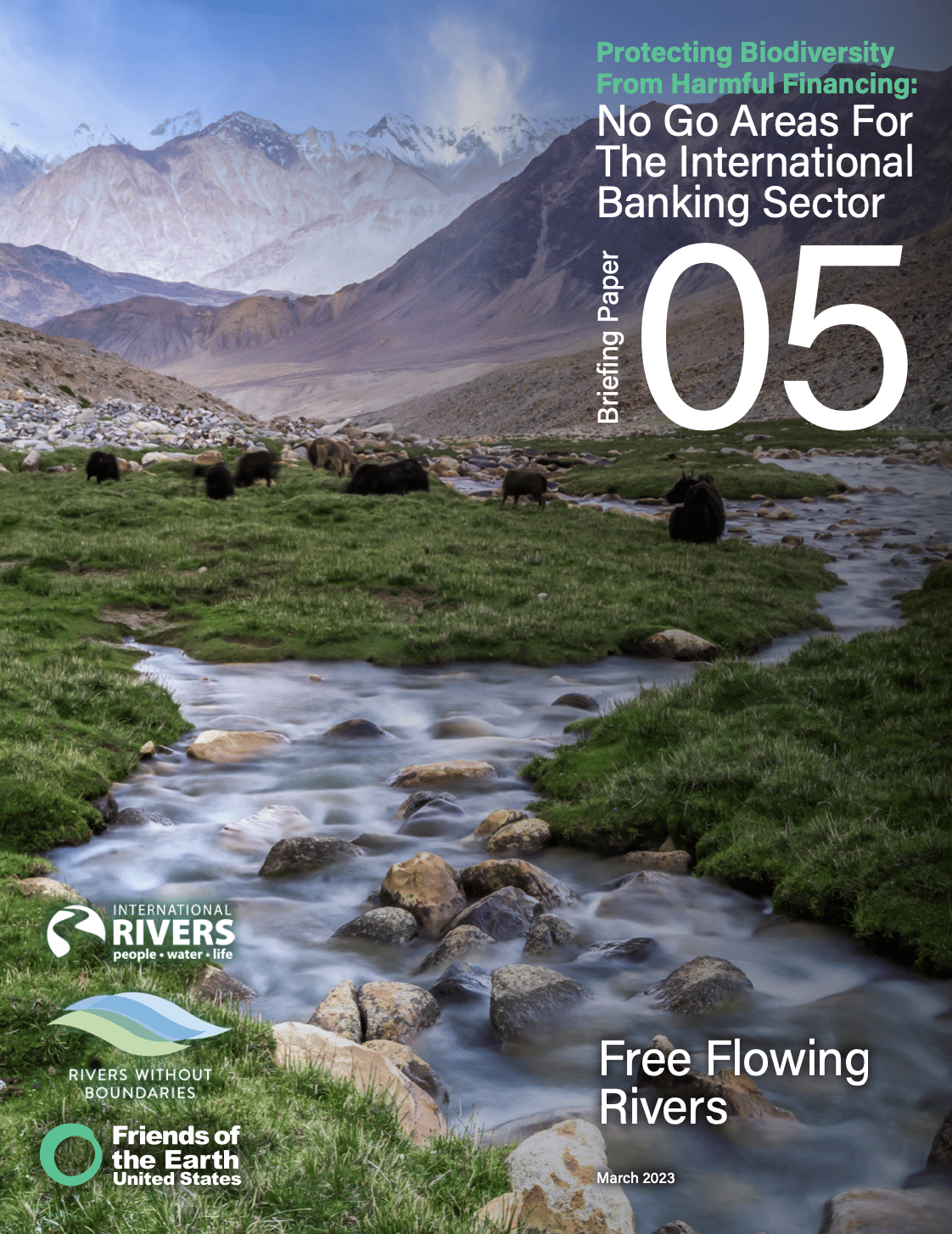Protecting Biodiversity from Harmful Financing: Free Flowing Rivers

Friends of the Earth US, International Rivers, and Rivers without Boundaries co-published a new briefing paper, called, “Protecting biodiversity from harmful financing: Free flowing rivers.” Published on World Water Day, the briefing paper explains why it is important for banks and financiers to prohibit direct and indirect financing to harmful activities which negatively impact or alter free flowing rivers.
The paper offers useful lessons and key takeaways on how the international banking sector can establish strong water and exclusionary policies in order to protect free flowing rivers and the communities reliant on them. Free flowing rivers are critical for safeguarding biodiversity, maintaining water supply, mitigating climate change, and supporting local and Indigenous communities. However, free flowing rivers are threatened by harmful dams and water infrastructure activities, which are often enabled by bank financing.
This paper is part of Friends of the Earth US’ new Protecting Biodiversity from Harmful Financing briefing paper series, which underscores why banks and financiers should exclude harmful, unsustainable financing to activities and projects which negatively impact critical, at-risk ecosystems. Each briefing paper is dedicated to a key area as identified by the Banks and Biodiversity Initiative’s eight proposed No Go areas. Free flowing rivers are considered as No Go Area 5, which is Paper 05 of the series. Briefing papers focusing on No Go Areas 6-8 are forthcoming.
Key Takeaways
- The Banks and Biodiversity Initiative defines free flowing rivers as rivers that flow undisturbed from their source to mouth, at either the coast, an inland sea or at the confluence with a larger river, without encountering any dams, weirs or barrages and without being hemmed in by dykes or levees
- Fluvial connectivity and hydrological alterations are key aspects when assessing the free flow of a river
- Banks and financiers should prohibit financing which negatively impacts the connectivity and flow of free flowing rivers, in order to preserve the livelihoods, biodiversity, and multiple other benefits of the world’s remaining free flowing rivers
- Freshwater river ecosystems are disappearing three times faster than forests
- A major driver of biodiversity and habitat loss in freshwater ecosystems is river fragmentation caused by dam building
- Harmful water and dam projects financed by banks are historically associated with high risks of negative reputational, environmental, social, and biodiversity impacts
- Banks and financiers should require free, prior, informed consent of impacted local and Indigenous communities across all transactions as a means to reduce the high risks associated with harmful water and dam projects
- Banks and financiers should support a moratorium on new dams in the economic recovery as a key step in reassessing energy options and plans, including all pipeline projects, and reducing the probability of increasing debt burdens from high-cost, high-risk/low reward projects
- Banks and financiers can facilitate opportunities to protect threatened biodiversity and freshwater ecosystems (and the communities and economies that rely on them) by moving energy production away from rivers
- Banks and financiers should prioritize upgrades to existing hydropower projects to increase efficiency instead of building new dams. This can include retrofitting turbines, improved pumped storage, protecting upstream forests and watersheds to reduce siltation, and grid-integration with wind, solar, and other energy innovations
- Banks and financiers should require clients to assess potential impacts of water related infrastructure and to conduct robust, thorough basin wide assessments which incorporate river pressure indicators and other criteria discussed in the Banks and Biodiversity Briefing Paper Series, “Protecting Biodiversity from Harmful Financing: No Go Areas for the International Banking Sector”
- Protecting rivers protects communities, and communities protect rivers
Friends of the Earth US is part of the Banks and Biodiversity Initiative, a civil society coalition which advocates that banks and financiers strengthen their biodiversity policies and practices in order to halt and reverse biodiversity loss. Learn more at Banksandbiodiversity.org.
Ways to Support Our Work

Read Latest News
Stay informed and inspired. Read our latest press releases to see how we’re making a difference for the planet.

See Our Impact
See the real wins your support made possible. Read about the campaign wins we’ve fought for and won together.

Donate Today
Help power change. It takes support from environmental champions like you to build a more healthy and just world.